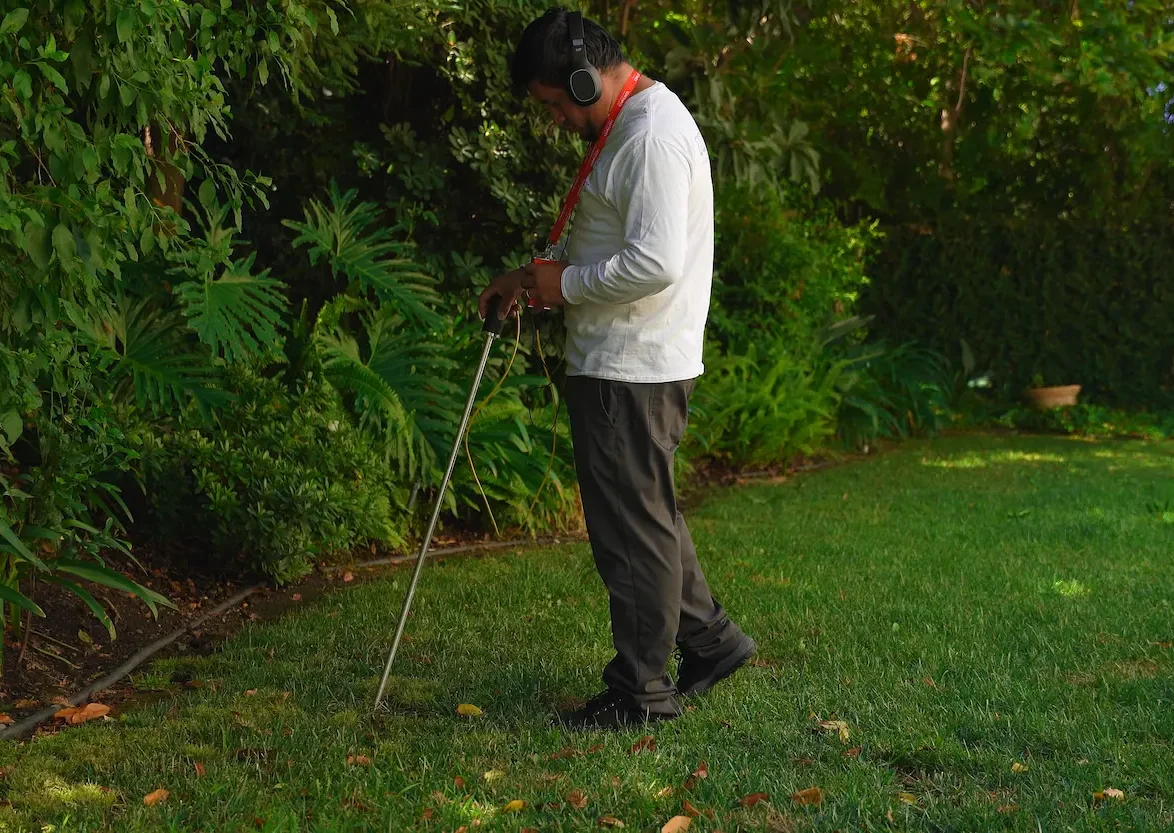I got a call from Steve, a customer who was using the VILO Vinyl Liner Leak Detection Kit for the first time and he was confused by what he experienced. That’s why we answer our phones, to help keep guys working. He said he had been used to years of using the Anderson/Fisher Vinyl Equipment with 16 AA batteries, lamp cord and a screwdriver to ground his unit. He said it felt assuring with our copper grounding rod, industrial cables and that he only need 2 batteries to power the amplifier. Then he said the problem came in.
He told me that when he got the LeakTronics equipment set up, he put the probes in the pool and didn’t immediately hear any noises. He scanned the pool for almost 10 minutes and suddenly the receiver started to buzz in the middle of shallow end. He didn’t understand why the device wasn’t making noise as soon as it was in the pool, after all, that’s what his Anderson device did. This is why he called.
What he told me is that when he uses his Anderson gear, the minute the probe is in the pool it starts making noise regardless of where it is in the pool and he can find the general area of where the leak is, for him, either on the left side of the pool, or the right side of the pool. Then he dives in the pool and swims around that side of the pool with dye and eventually he can find a leak.
This is something he could have done without the sensing equipment – just go for a swim. It’s a guessing game, not leak detection – a homeowner can do this on their own with food coloring.
With the LeakTronics equipment, he told me, it didn’t make any noise in the pool until he was right on top of the leak. He scanned the pool and nothing was happening, then suddenly, bam – noise. Well, that’s what the equipment does – it makes a noise to tell you where the leak is. Because of the squared voltage technology, once the float is in the pool, the electric charge finds the ground and the probes activate at the actual ground location, alerting you to where the leak is. He did it!
I asked him, “Did you find the leak?”
He stated, “I did, but I didn’t hear any noise until I was right on the leak. How am I supposed to find the leak?”
I was confused a little by what he was telling me. I said, “You found it, right where it was! You scan the pool liner until the probe identifies the leak, then it makes noise to alert you that you’re actually on the leak.”
I was baffled. He had found the leak with precision, the receiver made the identification noise right at the exact area where the leak occurred, so I asked him, “What was the problem?”
He then proceeded to scold me that he had to scan the whole liner of the pool to find the leak and normally he can sort of guess where the leak is and dive, he said it took longer to scan the liner before he started hearing noise.
Longer than it takes to put on diving gear and swim around a pool and make guesses as to where the leak is?!? He told me he found the leak in 10 minutes, exactly where it was!
I know, you’re reading this and thinking that this guy is an idiot. He’s not, he’s just confused. See, the problem here is that some guys are stuck in their old ways, the way their Pappy found leaks when Herbert Hoover was in office. They’re used to diving, swimming, dumping a gallon of dye into the pool and making a total fool of themselves in front of a customer who just wants the leak found and patched so they can go swimming. It doesn’t have to be this way.
Your old equipment and antiquated methods are hindering your ability to find leaks fast and accurately so you can get paid and move on to another job. We don’t use air tanks and flippers to find leaks, and frankly, neither should you. Don’t get me wrong, you can still dive a pool to verify a leak you found using dye, but why go diving when you don’t have to? When you have LeakTronics Vinyl Liner Leak Locating equipment; the most advanced, accurate and easy to use equipment in the world, you just find the leaks and get paid. Without it, you’re guessing where leaks are.
Get with the times and ditch the old bucket tests, throw out your mismatched equipment cobbled together by hobbyists trying to plug into Fisher amplifiers with add-on dongles and connectors ordered from China. LeakTronics equipment is manufactured in-house and warranted for repairs, and if you chose, for total no-question replacement for up to 5-years. You have the customer service from LeakTronics to walk you through any questions using the equipment and an option to take a complete Online Training Program that has launched the careers of thousands of professionals thriving in the field today all around the world – or like Steve, you can keep swimming in circles trying to guess where leaks are.
Are you ready to find leaks today and get paid for your work? Visit https://leaktronics.com or call 818-436-2953 and tell us you want to succeed. We’ll get you there.






